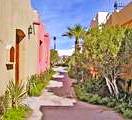
What is…
These are just a few definitions of environmental Architecture that are becoming reality, hopefully, leading the human race into a way of life that could be sustained for many more centuries to come.
What Is “Adaptive Reuse”?
Old buildings often outlive their original purposes. Adaptive reuse, or re-use, is a process that adapts buildings for new uses while retaining their historic features. An old factory may become an apartment building. A rundown church may find new life as a restaurant… And a restaurant may become a church.
One famous example of adaptive reuse is the Gallery of Modern Art for the Tate Museum in London. Designed by the Pritzker Prize winning architects Jacques Herzog and Pierre de Meuron, the museum was once a power station.
What Is “Sustainable Development”?
Sustainable development is development which meets the needs of the present without compromising the ability of future generations to meet their own needs.
The term sustainable development means that builders, architects, designers, community planners, and real estate developers strive to create buildings and communities that will not deplete natural resources. The goal is to meet today’s needs using renewable resources so that the needs of future generations will be provided for.
What is “Eco-friendly Architecture”?
Protecting and preserving the earth’s environment has become more of a priority in the past few years, especially regarding architecture in urban settings. The new trend of eco-friendly architecture is now aimed at big-city life in an attempt to reduce the amount of energy consumed, as well as making city life more agriculturally sustainable.
What Is “Green Architecture”?
Green architecture is an approach to building that minimizes harmful effects on human health and the environment. The “green” architect or designer attempts to safeguard air, water, and earth by choosing eco-friendly building materials and construction practices.